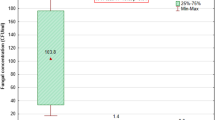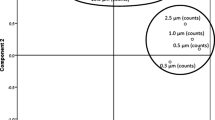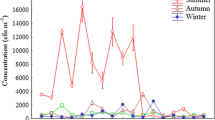Abstract
Farm workers are often exposed to high concentrations of airborne organic dust and fungal conidia, especially when working with plant materials. The purpose of this investigation was to study the possibility of exposure to the mycotoxin ochratoxin A (OTA) through inhalation of organic dust and conidia. Dust and aerosol samples were collected from three local cowsheds. Aerosol samples for determination of total conidia and dust concentrations were collected by stationary sampling on polycarbonate filters. Total dust was analysed by gravimetry, and conidia were counted using scanning electron microscopy. A method was developed for extraction and determination of OTA in small samples of settled dust. OTA was extracted with a mixture of methanol, chloroform, HCI, and water, purified on immunoaffinity column, and analysed by ion-pair HPLC with fluorescence detection. Recovery of OTA from spiked dust samples (0.9–1.0 μg/kg) was 74% (quantitation limit 0.150 μg/kg). OTA was found in 6 out of 14 settled dust samples (0.2–70 μg/kg). The total concentration of airborne conidia ranged from < 1.1 × 104 to 3.9 × 155 per m3, and the airborne dust concentration ranged from 0.08 to 0.21 mg/m3. Conidia collected from cultures of Penicillium verrucosum and Aspergillus ochraceus contained 0.4–0.7 and 0.02–0.06 pg OTA per conidium, respectively. Testing of conidial extracts from these fungi in a Bacillus subtilis bioassay indicated the presence of toxic compounds in addition to OTA. The results show that airborne dust and fungal conidia can be sources of OTA. Peak exposures to airborne OTA may be significant, e.g., in agricultural environments.
Similar content being viewed by others
References
Hendry KM, Cole EC. A review of mycotoxins in indoor air. J Toxicol Environ Health 1993; 38: 183-198.
Pitt JL. The current role of Aspergillus and Penicillium in human and animal health. J Med Vet Mycol 1994; 32 (Supplement I): 17-32.
Hintikka EL, Nikulin M. Airborne mycotoxins in agricultural and indoor environments. Indoor Air 1998; Suppl. 4: 66-70.
Sorenson WG. Fungal spores: Hazardous to health? Environ Health Perspect 1999; 107 (suppl. 3): 469-472.
Kuiper-Goodman F, Scott PM. Review: Risk assessment of the mycotoxin ochratoxin A. Biomed Environ Sci 1989; 2:179-248.
Gareis M, Märtlbauer E, Bauer J, Gedek B. Bestimmung von Ochratoxin A in Muttermilch. Zeitschrifl für lebensmitteluntersuchung und forschung 1988; 186: 114-117.
Hald B. Ochratoxin A in human blood in European countries. In: Castegnaro M, Pleština R, Dirheimer G, Chernozemsky IN, Bartsch H, eds. Mycotoxins, Endemic Nephropathy and Urinary Tract Tumours. Lyon: IARC, 1991: 159-164.
Breitholtz-Emanuelsson A, Olsen NI, Oskarsson A, Palminger I, Hult K. Ochratoxin A in cow's milk and in human milk with corresponding human blood samples. J AOAC Int 1993; 76(4): 842-846.
Jonsyn FE, Maxwell SM, Hendrickse RG. Ochratoxin A and aflatoxins in breast milk samples from Sierra Leone. Mycopathologia 1995; 131:121-126.
Micco C, Miraglia M, Brera C, Corneli S, Ambruzzi A. Evaluation of ochratoxin A in human milk in Italy. Food Addit Contam 1995:12(3): 351-354.
Zimmerli B, Dick R. Determination of ochratoxin A at the ppt level in human blood, serum, milk and some foodstuffs by high-performance liquid chromatography with enhanced fluorescence detection and immunoaffinity column cleanup: methodology and Swiss data. J Chromatogr B 1995; 666: 85-99.
Skaug MA, StØrmer FC, Saugstad OD. Ochratoxin A: a naturally occurring mycotoxin found in human milk samples from Norway. Acta Paediatr 1998; 87: 1275-1279.
Veldman A, Borggreve GJ, Mulders EJ, van de Lagemaat D. Occurrence of the mycotoxins ochratoxin A, zearalenone and deoxynivalenol in feed components. Food Addit Contam 1992; 9(6): 647-655.
Speijers GJA, van Egmond HP. Worldwide ochratoxin A levels in food and feeds. In: Creppy EE, Castegnaro M, Dirheimer G, eds. Human ochratoxicosis and its pathologies. Colloque INSERM, Montrouge, France: John Libbey Eurotext Ltd, 1993; 231: 85-100.
Scudamore KA, Hetmanski NIT. Natural occurrence of mycotoxins and mycotoxigenic fungi in cereals in the United Kingdom. Food Addit Contam 1995; 12(3): 377-382.
Höh1er D. Ochratoxin A in food and feed: occurrence, legislation and mode of action. Zeitschrift für Ernährungswissenschaft 1998; 37(1): 2-12.
Scudamore KA, Patel S Breeze V. Surveillance of stored grain from the 1997 harvest in the United Kingdom for ochratoxin A. Food Addit Contam 1999; 16(7): 281-290.
IARC. Monographs on the evaluation of carcinogenic risks to humans. Some naturally occurring substances: food items and constituents, heterocyclic aromatic amines and mycotoxins. Lyon: IARC 1993; Vol. 56.
JØgensen K, Rasmussen G, Thorup I. Ochratoxin A in Danish cereals 1986-1992 and daily intake by the Danish population. Food Addit Contam 1996; 13(1): 95-104.
Krogh P. Ochratoxins in food. In: Krogh P, ed. Mycotoxins in food. Food Science and Technology. A Series of Monographs. Academic Press, 1987: 97-121.
Pitt JI. Penicillium viridicatum, Penicillium verrucosum and production of ochratoxin A. Appl Environ Microbiol 1987; 53: 266-269.
Varga J, Kevei F, Rinyu E, Téren J, Kozakiewicz Z. Ochratoxin production by Aspergillus species. Appl Environ Microbiol 1996; 62(12): 4461-4464.
Frisvad JC, Samson A. Mycotoxins produced by species of Penicillium and Aspergillus occurring in cereals. In: Chelkowski J, ed. Cereal Grain. Mycotoxins, Fungi and Quality in Drying and Storage. Elsevier, 1991: 441-476.
Holmberg T, Breitholtz-Emanuelsson A, Haggblom P, Schwan 0, Hult K. Penicillium verrucosum in feed of ochratoxin Apositive swine herds. Mycopathologia 1991; 116(3): 169-176.
Mills JT. Mycotoxins and toxigenic fungi on cereal grains in western Canada. Can J Physiol Pharmacol 1990; 68(7): 982-986.
Mills JT, Seifert KA, Frisvad JC, Abramson D. Nephrotoxigenic Penicillium species occurring on farm-stored cereal grains in western Canada. Mycopathologia 1995; 130(1): 23-28.
Scudamore KA, Clarke JH, Hetmanski NIT. Isolation of Penicillium strains producing ochratoxin A, citrinin, xanthomegnin, viomellein and vioxanthin from stored cereal grains. Letters in Applied Microbiology 1993: 17(2): 82-87.
Škrinjar M, Stubblefield RD, Vujicic IF. Ochratoxigenic moulds and ochratoxin A in forages and grain feeds. Acta Vet Hung 1992; 40(3): 185-90.
Smith JE, Anderson JG, Lewis CW, Murad YM. Cytotoxic fungal spores in the indoor atmosphere of the damp domestic environment. FEMS Microbiol Lett 1992; 79(1-3): 337-343.
Karlsson K, Malmberg P. Characterization of exposure to molds and actinomycetes in agricultural dusts by scanning electron microscopy, fluorescence microscopy and the culture method. Scand J Work Environ Health 1989; 15(5): 353-359.
Lappalainen S, Nikulin M, Berg S Parikka P, Hintikka EL, Pasanen AL. Fusarium toxins and fungi associated with handling of grain on eight Finnish farms. Atmospheric Environment 1996; 30(17): 3059-3065.
Eduard W. Exposure to non-infectious microorganisms and endotoxins in agriculture. Ann Agric Environ Med 1997; 4: 179-186.
Lacey J, Dutkiewicz J. Bioaerosols and occupational lung disease. J. Aerosol Sci 1994: 25(8): 1371-1404.
Kullman GJ, Thorne PS, Waldron PF, Marx JJ, Ault B, Lewis DM, Siegel PD, Olenchock SA, Merchant JA. Organic dust exposure from work in dairy barns. Am Ind Hyg Assoc J 1998; 59:403-413.
Eduard W, Sandven P, Johansen BV, Bruun R. Identification and quantification of mould spores by scanning electron microscopy (SEM): Analysis of filter samples collected in Norwegian saw mills. Ann. Occup. Hyg. 1988; 32: 447-455.
Ramirez C. Manual and atlas of the Penicillia. Amsterdam: Elsevier Biomedical Press, 1982.
Bauer J, Gareis M. Ochratoxin A in der Nahrungsmittelkette. J Vet Med B 1987; 34: 613-627.
StØrmer FC, Sandven P, Huitfeldt HS, Eduard W, Skogstad A. Does the mycotoxin citrinin function as a sun protectant in conidia from Penicillium verrucosum? Mycopathologia 1998; 142: 43-47.
Davis BD, Mingioli ES. Mutants of Escherichia coli requiring methionine or B12. J. Bacteriol. 1950; 60: 17-28.
WHO Technical Report Series, 1991. Evaluation of certain food additives and contaminants. Thirty-seventh report of the Joint FAO/WHO Expert Committee on Food Additives, WHO Technical Report Series 806, Geneva.
Richard JL, Plattner RD, May J, Liska SL. The occurrence of ochratoxin A in dust collected from a problem household. Mycopathologia 1999; 146(2): 99-103.
Chu FS. Mycotoxin analysis. In: Jeon IJ, Ikins WG, eds. Analyzing food for nutrition labeling and hazardous contaminants. New York: Marcel Dekker, Inc, 1995: 283-332.
Di Paolo N, Guarnieri A, Loi F, Sacehi G, Mangiarotti AM, Di Paolo M. Acute renal failure from inhalation of mycotoxins. Nephron 1993; 64: 621-625.
Hanhela R, Louhelainen K, Pasanen AL. Prevalence of microfungi in Finnish cow barns and some aspects of the occurrence of Wallemia sebi and Fusaria. Scan J Work Environ Health 1995; 21: 223-228.
Breitholtz-Emanuelsson A, Fuchs R, Hult K. Toxicokinetics of ochratoxin A in rat following intratracheal administration. Nat Toxins 1995; 3: 101-103.
Author information
Authors and Affiliations
Rights and permissions
About this article
Cite this article
Skaug, M.A., Eduard, W. & Størmer, F.C. Ochratoxin A in airborne dust and fungal conidia. Mycopathologia 151, 93–98 (2001). https://doi.org/10.1023/A:1010953401173
Issue Date:
DOI: https://doi.org/10.1023/A:1010953401173




